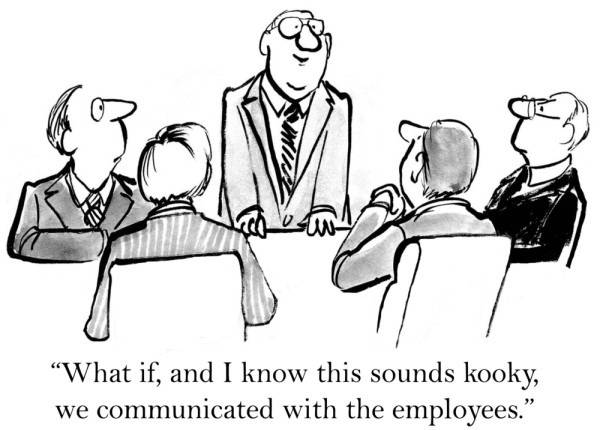The workplace has evolved. However, the core objectives of leadership are still the same. Their job is to connect, engage, and inspire employees to be their best. And the importance of employee experience should be a primary focus.

Workplace culture flows from all directions, bottom to top, top to bottom, and middle outwards. However, monkey see, monkey do. If your C-Suite isn’t working towards a stronger employee experience for all, your employees will become disengaged, and the entire company will suffer for it.
Employee experience initiatives, and a genuine commitment to enhancing EX in the end is paramount. Here are some stats which speak to the importance of strong and caring leadership at companies:
- In a study on employee experience by Gallup, employees shared that they are looking for leadership “who cares about them, keeps them accountable, and focuses on future excellence and career growth opportunities.”
- Business.com found that there are five core things that employees want from leadership, and among these is follow through. The other four are respect, to feel heard, honesty, and to be valued.
- Interact Studio conducted an online survey which found that 69% of managers say they are uncomfortable communicating with their employees.
And unfortunately, in our report on The State of EX, we found that more than 50% of our respondents said their leaders talked a good game about employee experience but didn’t have the action to back it up.
This is problematic, as communication is the heartbeat of any company. Another Gallup piece found that “employees who receive daily feedback from their manager are 3x more likely to be engaged than those who receive feedback once a year or less.” Additionally, the same report found that leadership alone “accounts for 70% of the variance in team engagement.” The importance of employee experience (and employee engagement) really does rest on the shoulders of the C-Suite.
And this is where Simpplr helps companies focus on the critical elements of EX. It provides executives with the insights and visibility they need to take effective action, and it equips everyone in your company to engage meaningfully by:
- Providing leadership with the tools to listen, and the confidence base decisions on internal data
- Making leadership more accessible to employees
- Offering real-time feedback so opportunities are not lost, and corrections can be made
This ultimately supports better decision-making and results in a stronger brand—and who doesn’t want more of those qualities?
Strengthening your employer brand
There are plenty of good reasons to want to strengthen your employer brand, and chief among them are to attract new talent by way of employee advocates.
Competition is stiff, and increasingly top talent searches for companies that value the importance of employee experience. And who better to talk all about that than current and former employees of a place?
Your C Suite has a direct impact in how your organization is perceived by outside talent looking for a job. Popular job sites offer an inside scoop, like Glassdoor. Here, employees of companies both look for and leave reviews on workplaces.
And if your current and former employees are happy, they will act as advocates to bolster your brand by sharing their joy with friends, family and strangers—not just on job review sites, but everywhere online, particularly social channels. They become your best advertisement to attract top talent and strengthen your brand’s standing in its category.
This means valuing employee experience becomes mission critical, as it can either create a solid brand perception, a foundation upon which many will base your reputation, or it can slowly chip away the same. Happy employees take exceptional care of customers, we know this to be intuitively correct. Yet we fail to consider the flip side of this understanding and overlooking it can prove fatal. Employees that feel little brand loyalty do not go above and beyond for customers, and their resentment often bleeds through.
With the power of an employee-centric intranet that’s laser-focused on EX, your C Suite will have the tools to make your company’s culture one where employees feel heard, valued, and are happy. And one that they tell the wider world about, with customer interactions that make your brand the talk of the virtual town.
Many executives know this, of course, and want to listen—but have trouble finding the time. It’s important to empower leadership to listen and course correct.
Empower leadership to listen and course correct
AI empowers your C Suite by aggregating employee data points and distilling actionable intelligence. But even that isn’t enough. Executives also need to be more visible.
By playing an involved part in the company and employees’ daily functions, leadership helps them feel confident in what they’re doing—which in turn boosts productivity and employee engagement. Additionally, when employees see that leadership cares, the C Suite becomes a working part of employee teams, not a faceless and unapproachable wizard behind the curtain. And you can bet that distinction (either way) makes its way into reviews.
According to McKinsey’s study on communication in the workplace after COVID-19, “44 percent of respondents to a survey of executives say that communication barriers cause delays or failure to complete projects, and 18 percent blame miscommunication for the loss of sales, some worth hundreds of thousands of dollars.”
Today, employee communication is a two-way street. The top-down approach to internal communications is no longer effective, assuming it ever was. And today’s talent expects more focused teamwork, collaboration, and interaction with leadership. With this, communications are incredibly important.

C Suite leaders must open up the floor for two-way communications—holding space for meaningful and transparent communications between the workforce and those leading them into battle. And the global marketplace is certainly a ‘winner takes all’ landscape some days!
The importance of employee experience can be measured by a company’s ability to share critical info with those who need it immediately, wherever employees are—smashing interdepartmental, geographical and role-based barriers. It’s how a company evolves and keeps pace with necessary changes. And it’s a lot to sort out if one isn’t using the right technology to power it.
With Simpplr’s platform, two-way communications are straightforward, with targeted communications that are relevant and focused on making a transparent culture happen—allowing employees (and your company) to simply flourishTM.
Employees see their workspace as an extension of themselves, and likewise, they want to feel free to be who they are. And companies can help them be the best version of that with a little listening and an emphasis on the importance of employee experience. Be sure to reach out for a demo to see the possibilities in action!

















